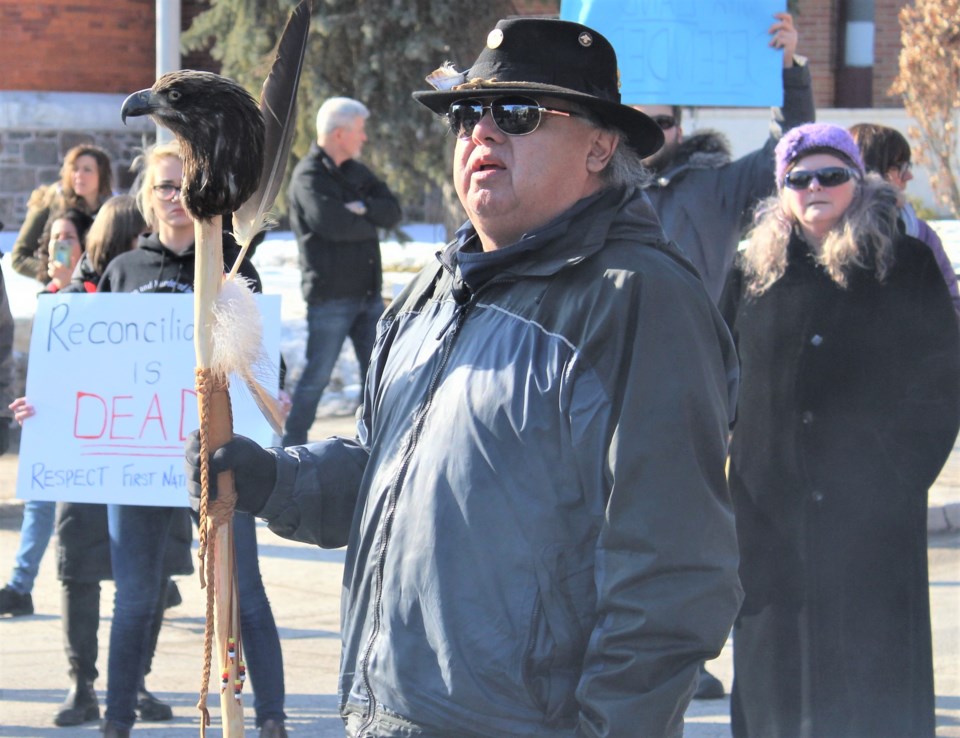This column was submitted by Jeff Monague, a former Chief of the Beausoleil First Nation on Christian Island, former Treaty Research Director with the Anishnabek (Union of Ontario Indians), and veteran of the Canadian Forces. Monague, who taught the Ojibwe language with the Simcoe County District School Board and Georgian College, is currently the Co-Manager at Springwater Provincial Park on behalf of the Beausoleil First Nation in partnership with Ontario. He is an elder and knowledge keeper for the Indigenous community. His column will be published every other week.
In 1838, Ogemaa (Chief) Essens, led a sit-in at the Coldwater Grist Mill right here in Simcoe County to protest the removal of his people from the land that the British Crown had promised they could live on forever.
He and a group of his men staged the protest as a last resort because they felt that their requests to stay on the land that they were promised had been unjustly ignored.
Adding to their unrest was the knowledge that the land was being sold out from under them even before they had begun to vacate the area. No treaty had been signed with the British beforehand, so the land theft was happening in real time. It was unceded territory.
The land that Ogemaa Essens and his men were protecting was known at the time as the Coldwater Narrows Reserve. It had been the most successful farming operation north of Toronto, and it was owned and operated by Ogemaa Essens and his people, my ancestors.
A scant 26 years earlier, in 1812, Ogemaa Essens had allied with the British and he, along with men and women warriors from his village, helped to repel invading American Forces at Niagara. For that service they received medals of honour and a promise, to live forever, unmolested, in their traditional territory.
Just one year earlier, in 1837, Ogemaa Essens led a contingent of warriors to Toronto to assist the British in the quelling of a rebellion. For that action, they again received medals, many of which are still held by their descendants in the communities of Christian Island, Rama and Georgina Island.
But things were about to change as now, their allyship was being questioned throughout their territory.
The British Military and the settler community became weary of Ogemaa Essen’s actions. Very quickly, the peaceful sit-in at the Coldwater grist mill was deemed an uprising. The Rule of Law was put into force and the British Military was sent in to forcibly remove Ogemaa Essens and his men.
Sound familiar?
This act has been played out time and again beginning even before Canada became a country. The British government, and later, after 1867, the Canadian government, have used the Rule of Law to remove Indigenous peoples from their own lands, even if they did not have the proper authority to do so.
What’s happening today in British Columbia with the Wet’suwe’ten Peoples involves the same tired formula.
- Indigenous people on unceded lands are not properly consulted on the taking of resources on their lands.
- Indigenous people protest, peacefully, the wrongs committed upon them, on their lands.
- The settler population becomes restless and uncomfortable with the uprising (peaceful protests) carried out by Indigenous people on their lands and demand that the government do something.
- The provincial and federal governments enact the Rule of Law and choose to quell the uprising (peaceful protest) using force, thereby abating the fears of its constituency.
In Canada, the Rule of Law is not for everyone, as is evident in British Columbia today, in 2020.
Although the Hereditary Chiefs of the Wet’suwet’en won a landmark Supreme Court of Canada decision in 1997, which ruled/upheld that the Hereditary Chiefs have full authority within Wet’suwet’en territory having never signed a Treaty with Canada, this country is choosing to build a pipeline through their unceded territory.
Canada is at Stage 4 in the formula above and has now moved into new uncharted territory because the governments did not anticipate a sympathetic backlash by Indigenous communities across Canada.
But we did not have to be here!
The government already has a path forward in its possession. Actually, two paths forward; the recommendations from the Royal Commission on Aboriginal Peoples (RCAP) completed after the Oka Crisis in 1990, and the Truth and Reconciliation Commission (TRC) with its 94 Calls to Action, completed in 2015.
The TRC actually talks about a path forward which, amazingly, has already been adopted by the British Columbia government in November 2019; the United Nations Declaration on Indigenous Peoples (UNDRIP).
As a matter of fact, TRC Call to Action #43 calls upon federal, provincial, territorial, and municipal governments to adopt and implement UNDRIP as a framework for reconciliation.
The governments need only to step back and start from the beginning. Employ the TRC’s Call to Action #92, which called upon the corporate sector to adopt the UNDRIP and to implement its principles and norms within the corporate sector. This can be done together with the Indigenous community, all governments, and corporate Canada.
Had this road map been followed we wouldn’t be here. The Rule of Law would have been respected.
But right now, the Rule of Law in Canada seems a dark, murky, place. So I’m sure that the governments are having trouble finding their way toward the solution.
But we see it!
